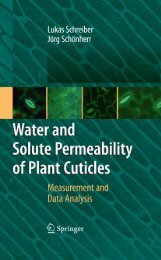Topics in Current Chemistry
Topics in Current Chemistry
Topics in Current Chemistry
Create successful ePaper yourself
Turn your PDF publications into a flip-book with our unique Google optimized e-Paper software.
Electronic Spectroscopy and Photoreactivity of Transition Metal Complexes 145<br />
ately followed <strong>in</strong> energy by MLCT (5d W!p * CO) states <strong>in</strong>stead of MC states.<br />
Similar trends have been observed for the bidentate substituted complexes<br />
W(CO) 4L (L=ethylenediam<strong>in</strong>e, N,N 0 -di-alkyl-1,4-diazabutadiene) on the basis<br />
of TD-DFT and CASPT2 calculations [125].<br />
3.2<br />
Metal-to-Ligand-Charge-Transfer a-Diim<strong>in</strong>e Complexes<br />
In a series of structurally related transition metal a-diim<strong>in</strong>e compounds, or<br />
even with<strong>in</strong> the same molecule several different types of Charge Transfer<br />
(CT) transitions (from the metal M, from an halide ligand X or an axial sM-L<br />
bond to the electron accept<strong>in</strong>g a-diim<strong>in</strong>e group) may be present <strong>in</strong> a limited<br />
doma<strong>in</strong> of the absorption spectrum (visible-near UV). This gives to this<br />
class of molecules unconventional photo-chemical/physical properties which<br />
may be tailored act<strong>in</strong>g on the electronic degree of delocalization between the<br />
metal centre, the a-diim<strong>in</strong>e group and the heteroligands. In order to understand<br />
the differences of spectroscopy and photo-reactivity observed <strong>in</strong> a variety<br />
of molecules [126–135] a systematic quantum chemical study has been<br />
performed for several MLCT a-diim<strong>in</strong>e model complexes [94, 136, 137]. A<br />
few examples are reported <strong>in</strong> the next follow<strong>in</strong>g sub-sections.<br />
3.2.1<br />
Near UV-visible Absorption Spectra of [Ru(E)(E 0 )(CO) 2(iPr-DAB)]<br />
(E=E 0 =SnPh 3 or Cl; E=SnPh 3 or Cl, E 0 =CH 3;<br />
iPr-DAB=N,N 0 -diisopropyl-1,4-diaza-1,3-butadiene)<br />
The near-UV/visible spectra of a series of [Ru(E)(E 0 )(CO) 2(iPr-DAB)]<br />
(E=E 0 =SnPh 3 or Cl; E=SnPh 3 or Cl, E 0 =CH 3; iPr-DAB=N,N 0 -diisopropyl-1,4diaza-1,3-butadiene)<br />
have been <strong>in</strong>vestigated on the basis of theoretical and<br />
experimental analysis of model and real molecules, respectively [94].<br />
The lowest-energy part of the absorption spectra of both [Ru(SnH 3) 2<br />
(CO) 2(Me-DAB)] and [Ru(SnH 3)(CH 3)(CO) 2(Me-DAB)] model complexes<br />
orig<strong>in</strong>ates <strong>in</strong> an electronic transition that corresponds to excitation from an<br />
axial E-Ru-SnH 3 (E=SnH 3 or Me) s E-Ru-SnH3 orbital <strong>in</strong>to the low-ly<strong>in</strong>g p * DAB<br />
orbital localized predom<strong>in</strong>antly on Me-DAB (SBLCT transition) (Scheme 6).<br />
The first <strong>in</strong>tense band observed at 2.36 eV and 2.32 eV for [Ru(SnPh 3) 2<br />
(CO) 2(iPr-DAB)] and [Ru(SnPh 3)(Me)(CO) 2(iPr-DAB)], respectively have<br />
been assigned to SBLCT transitions calculated at 2.66 eV (b 1 A 1) and 2.55 eV<br />
(b 1 A 0 ) at the CASPT2 level (Table 3). The near-UV region dom<strong>in</strong>ated by<br />
weak shoulders at 3.12 eV [Ru(SnPh 3) 2(CO) 2(iPr-DAB)] and at ~2.75 eV and<br />
3.17 eV [Ru(SnPh 3)(Me)(CO) 2(iPr-DAB)] consists ma<strong>in</strong>ly of MLCT<br />
(4d Ru!p * DAB) transitions calculated at 3.08 eV (a 1 B 2) and 2.60 eV (a 1 A 00 )/<br />
3.21 eV (c 1 A 0 ) for [Ru(SnH 3) 2(CO) 2(Me-DAB)] and [Ru(SnH 3)(CH 3)(CO) 2<br />
(Me-DAB)], respectively. This assignment is confirmed by the TD-DFT







